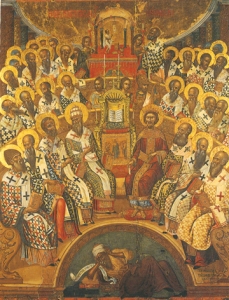Tags
Barlaamism, Ecumenical Synods, Eldress Evlampia Romanides, Hesychasm, Patristic Theology, Protopresbyter George Florovsky, Protopresbyter George Metallinos, Protopresbyter John Romanides, St. Gregory Palamas, The Wiles of the Devil
…Continued from Part 2
Councils, Synods and Civilization (Part 3)
By Protopresbyter John Romanides
2) Synods as Associations of Psychiatric Clinics.
We must have a clear vision of the context within which both Church and State saw the contribution of the Prophets to the cure of the sickness of the human personality and its perfection in order to understand both the mission of Synods and the reason why the Roman Empire incorporated them into its code of law. Neither Church nor State reduced the mission of the Church to salvation by forgiveness of sins for entrance into heaven after death. This would be identical to doctors forgiving their patients for being sick so that they may be cured after death. Both Church and State knew very well that forgiveness of sins was only the beginning of the cure of the happiness-seeking sickness of humanity. This cure passed through the purification and illumination of the heart and culminated in the perfection of glorification. This resulted not only in proper preparation for life after death but also in the transformation of society here and now from that of selfish and self-centred individuals to that of individuals with selfless love which does not seek its own.
a) Heaven and Hell.
 Everyone will see the glory of God in Christ and reach that degree of perfection one has both chosen and worked for. Following Saint Paul and the Gospel of John, the Fathers support that those who do not see the resurrected Christ in glory in this life, either in a mirror dimly by unceasing prayers and psalms in the heart, or face to face in glorification, will see His glory as eternal and consuming fire and outer darkness in the next life. The uncreated glory that Christ has by nature from the Father is heaven for those whose selfish love has been cured and transformed into selfless love, and hell for those who choose to remain uncured in their selfishness.
Everyone will see the glory of God in Christ and reach that degree of perfection one has both chosen and worked for. Following Saint Paul and the Gospel of John, the Fathers support that those who do not see the resurrected Christ in glory in this life, either in a mirror dimly by unceasing prayers and psalms in the heart, or face to face in glorification, will see His glory as eternal and consuming fire and outer darkness in the next life. The uncreated glory that Christ has by nature from the Father is heaven for those whose selfish love has been cured and transformed into selfless love, and hell for those who choose to remain uncured in their selfishness.
Not only are the Bible and the Fathers clear on this, but so are the Orthodox Icons of the last judgement. The same golden light of glory within which Christ and His friends are enveloped becomes red as it flows down to envelope the damned. This is the glory and love of Christ, which purifies the sins of all but does not glorify all. All humans will be led by the Holy Spirit into all the Truth which is to see Christ in glory, but not all will be glorified. “Those whom he justified those he also glorified”, according to St. Paul (Rom. 8:30). The parable of Lazarus in the bosom of Abraham and of the rich man in the place of torment is clear. The rich man sees but he does not participate (Luke 16:19-31 ) .
The Church does not send anyone to heaven or hell, but prepares the faithful for the vision of Christ in glory, which everyone will have. God loves the damned as much as He loves His saints. He wants the cure of all but not all accept His cure. This means that the forgiveness of sins is not sufficient preparation for seeing Christ in glory.
It goes without saying that the Anselmian tradition whereby the saved are those to whom Christ supposedly reconciled God is not an option within the Orthodox Tradition. Commenting on 2 Cor. 5:19, for example, St. John Chrysostomos says that one must “be reconciled to God. Paul did not say, `Reconcile God to yourselves’, for it is not He who hates, but we. For God never hates”.
It is within the above context that the State understood the Church’s mission of cure within society. Otherwise religions promising happiness after death are not much different from each other.
…to be continued

+++

You must be logged in to post a comment.